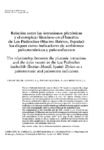Relación entre las intrusiones plutónicas y el complejo filoniano en el batolito de Los Pedroches (Macizo Ibérico, España): los diques como indicadores de ambientes paleotectónicos y paleoesfuerzos

View/
Use this link to cite
http://hdl.handle.net/2183/6278Collections
Metadata
Show full item recordTitle
Relación entre las intrusiones plutónicas y el complejo filoniano en el batolito de Los Pedroches (Macizo Ibérico, España): los diques como indicadores de ambientes paleotectónicos y paleoesfuerzosAlternative Title(s)
The relationship between the plutonic intrusions and the dyke swarm in the Los Pedroches batholith (Iberian Massif, Spain): Dykes as a paleotectonic and paleostress indicatorsDate
1997Citation
Cadernos do Laboratorio Xeolóxico de Laxe, 1997, 22: 229-246 ISSN: 0213-4497
Abstract
[Abstract] The Los Pedroches batholith (Iberian Massif, SW Spain) is composed by a large biotite ±amphibole granodiorite pluton and several, smaller variable porphyritic, biotite ± cordierite granite intrusions. A dyke swarm composed esencially by trachyandesites, dacites and rhyolites cross cut the batholith. The whole set of plutonic and subvolcanic rocks define a K-rich, calc-alkaline alumino-cafemic association; only the trachyandesitic dykes ofshoshonitic affinity, get offthis trend. The dacitic and rhyolitic dykes are cogenetic with and probably comagmatic with thegranodioritic plutonand thegranitic intrusions, respectively. The trachyandesites, locallyshows sin-plutonic relations with thegranodiorite bodyand might becogenetic with mafic microgranular enclaves scattered through the granodiritic unit. The emplacement of the batholith and the dyke swarms is late-hercynian and postcollisional (300 Ma) and, was controled by a transtensional shear zone at acrustal scale. The dyke swarm use the tectonically generated fracture system during cooling and consolidation of the plutonic rocks: (i) R' type Riedel fractures for the trachyandesitic and dacitic dykes emplacement, and (ii) R type Riedel fractures for rhyolitic dykes emplacement. The arrangement ofsome dyke swarms can be use as a paleotectonic and paleostress indicators..
Keywords
Dykes
The Los Pedroches batholit
Paleostress indicators
The Los Pedroches batholit
Paleostress indicators
ISSN
0213-4497





